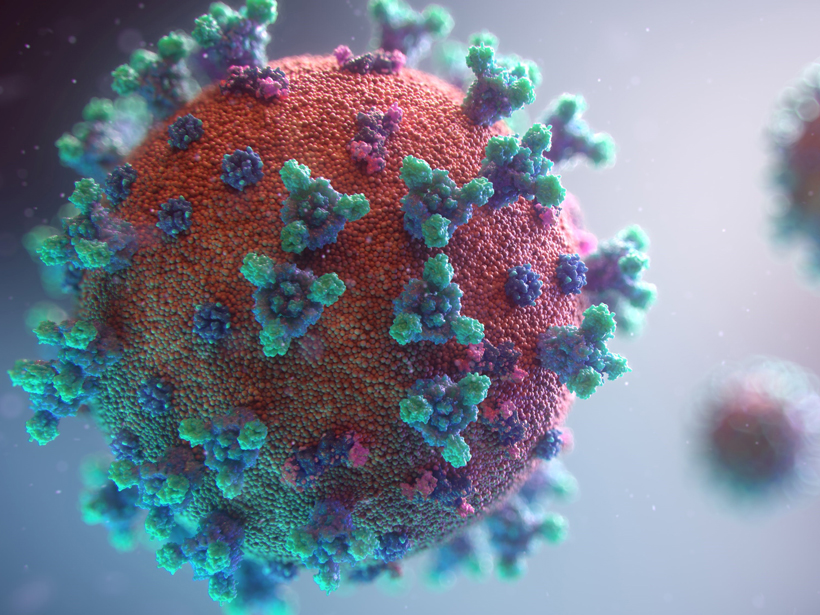We are living in exceptional and difficult times due to the spread of SARS-CoV-2, the virus responsible for the coronavirus pandemic (COVID-19), which has significantly disrupted the usual rhythm of our days. As Earth and space scientists, we believe we can offer insights into the pandemic and work collectively towards solutions.
The coronavirus pandemic is truly a global health crisis that has affected every country around the world. Governments have imposed severe restrictions on their populations in a bid to stop the spread of coronavirus, including strict controls on internal travel, bans on foreign visitors, and orders for people to stay in their homes. At the time of writing in mid-May, the virus has infected over 4.6 million people and killed more than 311,500 across the world in under six months (data from the Center for Systems Science and Engineering at Johns Hopkins University).
Earth and space scientists have an important role to play. They can offer valuable insights into the coronavirus pandemic and other global health challenges.
While the immediate concern during this public health emergency is focused on the provision of medical care and interventions to reduce transmission, this is not only an issue for biomedical scientists, virologists and public policy experts to tackle. Earth and space scientists have an important role to play too. Soil scientists, climate modelers, hydrologists and people from many other disciplines can offer valuable insights into the coronavirus pandemic and other global health challenges.
Planetary changes
During recent decades, humans have been exploiting the natural resources of our planet – fossil fuels, water, land, timber, minerals, wildlife and much more. The need and desire for more natural resources has led humans to encroach on various natural habitats. This results in expansion of “ecotones”, where species assemblages from different habitats mix, providing new opportunities for “spillover” of pathogens from wild animals and insects into human beings.
What we are experiencing is not the first case of human diseases originating from indiscriminate contacts with infected animals. For example, the emergence of the human immunodeficiency virus (HIV) is believed to have arisen from the hunting of nonhuman primates (chimpanzees) for food in central African forests. The outbreaks of Ebola hemorrhagic fever from 1999 and other coronaviruses such as SARS (severe acute respiratory syndrome coronavirus, SARS-CoV) in 2003 and MERS (Middle East respiratory syndrome coronavirus, MERS-CoV) in 2012, were also triggered by a jump from animal to human in disturbed natural habitats. Phylogenetic analysis of the novel SARS-CoV-2 virus suggests an initial single-locus zoonotic spillover event in December 2019 at a wet market in the large, modern city of Wuhan (Hubei province, central China), where wildlife was being sold, often in unhygienic conditions.
While these examples may have happened in places far from where we live, we must share a collective responsibility for this as 21st century humans in a globalized world. Across all continents, human populations are expanding their footprint as ever-more land is used for settlements, agriculture and natural resource extraction. This penetration into wildlife habitats increases the risk of spillover of zoonotic viruses and the rate of future zoonotic disease emergence will be linked to the evolution of the agriculture–environment nexus.
The changing climate is another factor to consider in the spread of the virus. Inter-annual and inter-decadal climate variability interacts with environmental and land-use changes affecting the survival, reproduction and distribution of disease pathogens and their hosts to contribute to disease emergence. The corresponding rise in annual average temperatures has altered the habitat of pathogen-carrying insects causing outbreaks, such as West Nile, Chikungunya, Dengue, and Zika diseases, to appear in new geographic regions.
A need for convergent research
There is an urgent need for convergent research focusing on biological, ecological and social drivers of pathogen emergence and distribution. Through holistic, integrated and interdisciplinary studies and codesign with, and participation of, relevant stakeholders we must focus our attention on pathogen dynamics at the wildlife–livestock–human interface along with the influence of warmer temperatures on disease vectors.
Earth and space science is the science of the 21st century. All disciplines of our science can produce the knowledge and expertise needed to address the grand societal challenges that we collectively face.
Earth and space science is the science of the 21st century. All disciplines of our science can produce the knowledge and expertise needed to address the grand societal challenges that we collectively face. These challenges transcend borders and politics. We must take this opportunity and broaden our reach by inviting those in other domains of science and relevant stakeholders to work with us in co-designing and co-producing knowledge and solutions. Through this, we will advance knowledge and create solutions that benefit communities, places and environments, and contribute towards the sustainability of our planet.
— Fabio Florindo ([email protected]), Editor in Chief, Reviews of Geophysics; and Christine McEntee, former Executive Director and CEO of AGU
Citation:
Florindo, F., C. McEntee (2020), The role of Earth and space scientists during pandemics, Eos, 101, https://doi.org/10.1029/2020EO144499. Published on 26 May 2020.
Text © 2020. The authors. CC BY-NC-ND 3.0
Except where otherwise noted, images are subject to copyright. Any reuse without express permission from the copyright owner is prohibited.

